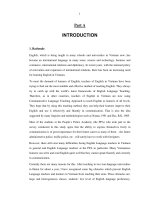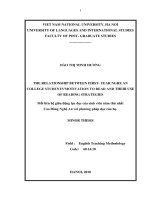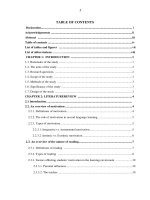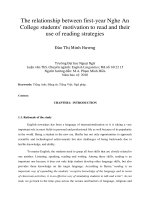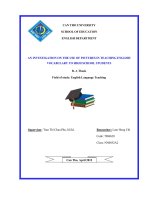The use of reading strategies when reading ESP by 4th-year English-majored students at the People’s Security Academy
Bạn đang xem bản rút gọn của tài liệu. Xem và tải ngay bản đầy đủ của tài liệu tại đây (185.7 KB, 7 trang )
The use of reading strategies when reading ESP
by 4
th
-year English-majored students at the
People’s Security Academy
Nguyễn Khả Thanh Tùng
Trường Đại học Ngoại ngữ
Luận văn ThS. Chuyên ngành: English teaching methodology; Mã số: 60 14 10
Người hướng dẫn: Hoang Thi Xuan Hoa, M.A
Năm bảo vệ: 2013
Keywords: Tiếng Anh; Phương pháp giảng dạy; Ngôn ngữ; Kỹ năng đọc hiểu
Content
PART I: INTRODUCTION
1. Rationale
English has been widely used in many areas such as politics, economics, tourism,
telecommunication, culture, science and technology. In the current context of global integration,
English which has become more and more important is not only a means of but also a key to accessing
the latest scientific and technological achievements. Therefore, it is necessary for many Vietnamese
students to have a good command of English to satisfy the growing demands in a developing country
like Vietnam.
Internationally, teaching English has changed tremendously over the last few decades.
More significantly, the traditional teacher-centered approach has been replaced with the learner-
center one, which reflects a desire to explore ways of making responsive to learner’s need and
interest and allowing learners to play a more active and participatory role in the day-to-day
teaching and learning processes. Therefore, no longer does the teacher act as the centre of all
instructions, controlling every aspect of the learning process. Learners themselves now, more
than ever, are sharing the responsibility for successful language acquisition and in doing so, are
becoming less dependent on the language teacher for meeting their own individual language
needs. Students are advised to become more and more autonomous to diagnose their own
learning strengths and weaknesses and to self-direct the process of language development.
Reading is considered one of the most important skills which language learners should
master, particularly as it helps to build a variety of language expression and structures, widen
general knowledge and leads to lifelong learning and improvement in the first and second language
skills. “Reading is an essential skill for English as a second/foreign language (ESL/EFL) student;
and for many, reading is the most important skill to master” (Anderson, 1999). Carrell (1984:1)
states “For many students, reading is by far the most important of four skills in a second language,
particularly in a language as a second or foreign language”. This is true for Vietnamese learners
who have studied English through reading since English is taught and learned as a foreign
language and in a non-native environment. But acquiring and mastering this skill is likely to be a
big hindrance to many learners while they often find it difficult to exploit this skill in their learning
experience. On the other hand, the findings of many ESL/EFL research projects have shown the
positive effects of learning strategies to enhance the comprehensibility of learners or to overcome
comprehension failures. The use of suitable language learning strategies can improve proficiency
and greater self-confidence.
In process of teaching and learning English as a foreign language in Vietnam in general,
and at the People’s Security Academy (PSA) in particular, reading has always been attracted a
great deal of attention both from the teachers and the students. Reading is regarded as an
important skill to the students because these students need to read a lot of English books and
documents to support their professional studies. Having taught English majored students at PSA
for several years, I am aware of their problems and very much want to help them to improve
their reading ability. Therefore, I conducted a survey research on their use of reading strategies.
Based on the findings, I worked out some solutions to improve PSA students' reading
proficiency.
2. Aim of the study
The major purpose of this study is to identify the reading strategies utilized by fourth-
year English-majored students at the PSA.
In order to achieve the above the aim of the study, the following major research question
was addressed:
What are the reading strategies employed by fourth-year English-majored students at the
People’s Security Academy?
3. Significance of the study
The study is the first one to be carried out in the field of reading strategies research at the
PSA. It helps give a detailed description of reading strategies used by fourth-year English-
majored students at the PSA. More importantly, the findings of their reading strategies can help
teachers to understand more about their students and they can serve as the foundation for some
recommendations on how to improve the students' reading proficiency. They are also an
important basis for reading strategies based instruction to be implemented in the future.
4. Method of the study
In order to achieve the aim mentioned above, the present study utilized survey research
with two instruments the questionnaire for 35 fourth-year English-majored students of class
AV41 and interviews for 4 teachers to collect data on the students’ reading strategies.
The questionnaire designed as a means to make the researcher’s evaluation more
objective was developed and given to 35 fourth-year English-majored students of class AV41.
The interviews were conducted among four teachers who have been teaching reading for
4
th
-year English-majored students to obtain their perceptions, comments and evaluation toward
the matter under investigation.
After the data was analyzed and discussed, some conclusions were drawn, and some
suggestions were raised in the thesis.
5. Scope of the study
The present study investigated “the use of reading strategies when reading ESP by 4
th
-
year English-majored students at the People’s Security Academy”. The study of learning
strategies in other English skills was beyond the scope.
6. Organization of the study
The study is divided into three main parts: the introduction, the development and the
conclusion.
Part I: Introduction includes the rationale, scope, aims, significance, methods and
organization of the study.
Part II: Development consists of three chapters
Chapter 1 reviews the literature relevant to the topic of research and summarizes some
selected studies on reading strategies, which serve as a theoretical and methodological
foundation of the study.
Chapter 2 presents the research methodology of the study. It provides information about
the participants, the research method, the instrumentation, the data collection procedures and
data analysis.
Chapter 3 presents the results of the study, analyzes the data
Part III: Conclusion summarizes the findings, presents the implications and limitations of
the study and finally gives some suggestions for further research.
REFERENCES
1. Aebersold J, A & Field, L, M (1997). From Reader to Reading Teacher. Cambridge
University Press.
2. Anderson, N, J (1999). Exploring Second Language Reading: Issues and Strategies. Heinle &
Heinle Publisher.
3. Anderson, N, J (1999). Improving Reading Speed, English Teaching Form. 21, pp.2-4.
4. Anderson, J.R. (1985). Cognitive Psychology and Its Implication. (2
nd
edn). W.H. Freeman.
5. Barnett, M.A (1988). Reading Through Context: How Real and Perceived Strategy Use
Affects L2 Comprehension, Modern Language Journal. 72, pp. 150-160.
6. Block, E. (1986). The Comprehension Strategies of Second Language Readers, TESOL
Quarterly, 20, pp. 319-341.
7. Block, E. 1992. See How They Read: Comprehension Monitoring of L1 and L2 Readers,
TESOL Quarterly, 26, pp. 319-341.
8. Brantmeier, C (2002). Second Language Reading Strategy Research at the Secondary and
University Levels: Variations, Disparities and Generalizability, The Reading Matrix,
Vol.3, pp. 1-14.
9. Brown, J.D. (1988). Understanding Research in Second Language Learning. Cambridge
University Press.
10. Carrell, P, J.Devine and D. Eskey (eds). (1984). Interactive Approaches to Second Language
Reading. Cambridge University Press.
11. Carrell, P.L (1989), “Metacognitive awareness and second language reading”, Modern
Language Journal, 73 (2), pp.121-34.
12. Cohen, A (1998). Strategies in Learning and Using Second Language. Longman.
13. Ellis, R. (1994). The Study of Second Language Acquisition. Oxford University Press.
14. Eskey, D.E (1988). Holding in the bottom: An Interactive Approach to the Language
Problems of Second Language Readers, in Carrel, P.L; Devine, J; Eskey, D.E (Eds),
Interactive Approach to Second Language Reading, pp 74-93. Cambridge: Cambridge
University Press.
15. Goodman, K (1988). The reading process. In P. Carrel, Devine J; Eskey, D.E (Eds),
Interactive Approach to Second Language Reading, pp 74-93. Cambridge University
Press.
16. Ha, N.T.T (2006). A study on English Reading strategies employed by Second Year Bridge
and Road Students University of Transport and Communications. Unpublished M.A
thesis. Hanoi: Vietnam National University
17. Hosenfeld, C. (1984). Case studies of ninth grade readers. In J. C. Alderson & A. H.
Urquhart (Eds.), Reading in a foreign language (pp. 231–240). London: Longman.
18. Hudson, T. (1998). Theoretical perspectives on reading. Annual Review of Applied
Linguistics: XVIII. 43-60. Cambridge University Press.
19. Naiman, N., Fronlich, M., Stern, H.H., and Todesco, A.1978. The good language learner.
Philadenphia, PA: Multilingual Matters.
20. Nunan, D. (1990). Research Methods in Language Learning. Cambridge University Press.
21. Nunan, D. (1991). Language Teaching Methodology. Prentice Hall International Ltd.
22. Nuttall, C (2000). Teaching reading skills in a foreign language. London: Heinemann
23. O'Malley, J.M & Chamot, A.U (1990). Learning Strategies in Second language Acquisition.
Cambridge University Press.
24. Oxford, R.L. (1990). Language Learning Strategies: What Every Teacher Should Know,
Newbury House.
25. Rubin, J.1981. What the “good language learner” can teach us. TESOL Quarterly, 9, 41-51
26. Rubin, J & Thompson, I. (1994). How to be a More Successful Language Learner. Heinle
and Heinle Publisher.
27. Rumelhart, D.E. (1977). Toward an Interactive Model of Reading, Attention and
Performance 6, pp. 573-603.
28. Samuel, S and M.Kamil (1988). Models of the Reading Process, in Interactive Approaches to
Second Language Reading, pp. 22-34. Cambridge University Press.
29. Sarig (1987). High-level Reading in the First and in the Foreign Language: Some
Comparative Process Data, in Joan devine, P.L. Carrel & D.E. Eskey (Eds), Research in
Reading in English as a Second Language, Washington, TESOL, pp. 102-120.
30. Stanovich, K, E (1980). Toward an Interactive-Compensatory Model of Individual
Differences in the Development of Reading Fluency, Reading Research Quarterly 16 (1),
pp. 32-71.
31. Stern, H.H. (1975). What Can We learn From The Good Language Learner? Canadian
Modern Language Review 31, pp. 285-295.
32. Tarone, E. (1981). Some Thoughts on The Notion of Communication Strategy, TESOL
Quarterly 15, pp. 285-295.
33. Ur, P. (1996). A course in Language Teaching. Cambridge: Cambridge University Press
34. Wenden, A.L. (1983). Learner Strategies in language learning, TESOL Quarterly 19 (5), pp.
1-7.
